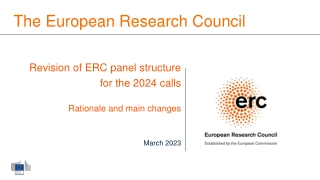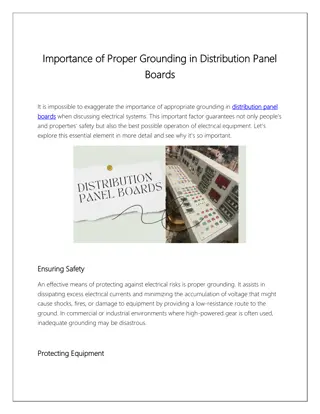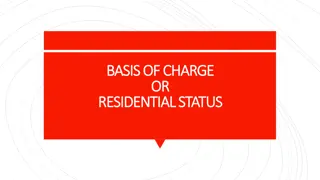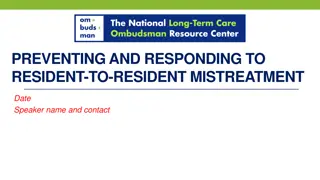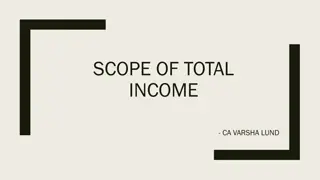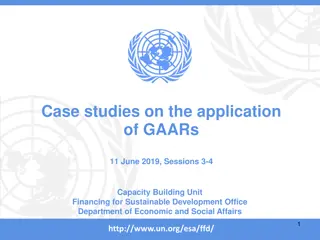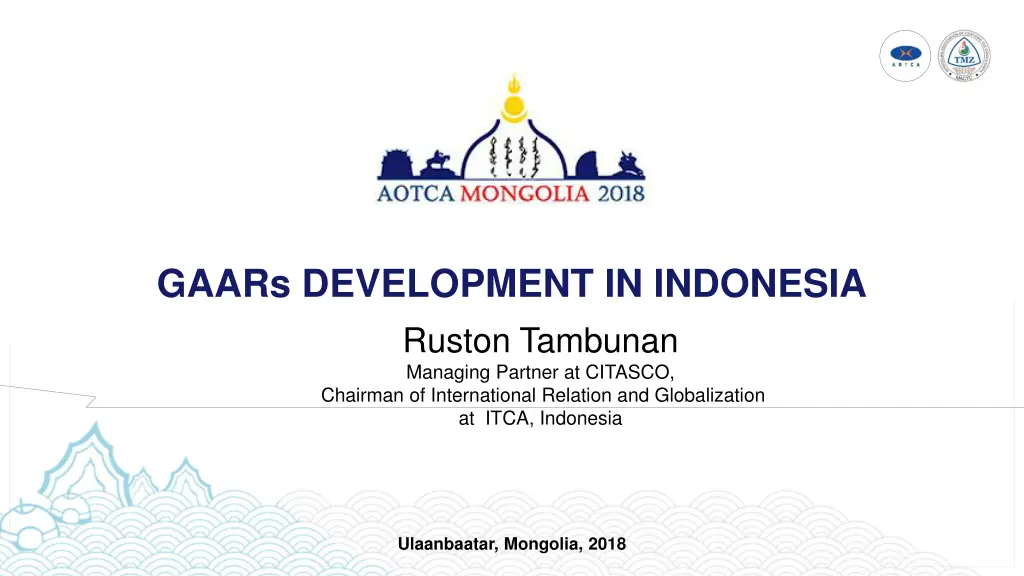
Developments in Anti-Avoidance Rules in Indonesia
Learn about General Anti-Avoidance Rules (GAARs) and Specific Anti-Avoidance Rules (SAARs) in Indonesia. Explore Thin Capitalisation Rules and other regulations aimed at preventing tax avoidance practices. Understand how these rules impact taxpayers and the tax authority.
Download Presentation

Please find below an Image/Link to download the presentation.
The content on the website is provided AS IS for your information and personal use only. It may not be sold, licensed, or shared on other websites without obtaining consent from the author. If you encounter any issues during the download, it is possible that the publisher has removed the file from their server.
You are allowed to download the files provided on this website for personal or commercial use, subject to the condition that they are used lawfully. All files are the property of their respective owners.
The content on the website is provided AS IS for your information and personal use only. It may not be sold, licensed, or shared on other websites without obtaining consent from the author.
E N D
Presentation Transcript
GAARs DEVELOPMENT IN INDONESIA Ruston Tambunan Managing Partner at CITASCO, Chairman of International Relation and Globalization at ITCA, Indonesia Ulaanbaatar, Mongolia, 2018
GENERAL ANTI AVOIDANCE RULES (GAARS) General anti-avoidance rules are domestic rules that allow the tax authority to recharacterize a transaction or a series of transactions that have been entered with the (sole or main) purpose of obtaining undue tax benefits. Many domestic tax system contain such rules, either in the form of an expressed provision incorporated into tax code or in the form of a general principle of abuse of law, generally developed by local judges in domestic This is typically achieved by giving the tax authority the power to cancel a particular tax benefit or assess a different (increased) tax liability against the taxpayer in circumstances where the course of action taken by a taxpayer is so blatant, artificial or contrived that it is only explicable by the desire to obtain a relevant tax benefit. case law. (Raffaele Russo, 2007) Currently, Indonesia does not have statutory General Anti Avoidance Rules (GAARs) as well as the Judicial Anti-Avoidance Doctrine but adopt Specific Anti Avoidance Rules (SAARs). 01
SPECIFIC ANTI AVOIDANCE RULES (SAARs) IN INDONESIA A. THIN CAPITALISATION RULES B. TRANSFER PRICING RULES C. CONTROLLED FOREIGN COMPANY (CFC) RULES D. ANTI TREATY ABUSE E. ANTI STEPPING RULES 02
A. THIN CAPITALISATION RULES Law Number 7 of the Year 1983 as lastly amended by Law Number 36 of the Year 2008 regarding Income Tax Law, Article 18, section 1 : The Minister of Finance is authorized to issue a regulation on debt to equity ratio for tax calculation under this law. Regulation of the Minister of Finance Number: 169/PMK.010/2015 ( PMK 169 )effectively enforcedfor the fiscal year 2016 onwards: Debt to Equity Ratio (DER) maximum of 4:1 Determination of debt and equity balances will use the average of the month-end balances. The term debt includes short and long-term debts and interest-bearing trade payables. The term equity is the amount shown on financial statements but increased by intercompany interest-free loans. DER regulations disallow any borrowing costs more than liability over the 4:1 DER as deductible expense 03
THIN CAPITALISATION RULES (2) For taxpayers with zero or negative equity, the entire borrowing cost expense will be disallowed for income tax calculation purposes. Cost of borrowing include the following: Interest; Discounts and premiums in connection with the debt; Additional costs incurred concerning the arrangement of borrowings; Finance charges on finance leases; Guarantee fees; and Foreign exchange differences arising from loans in foreign currencies (as long as the differences are adjustments to the interest expense and other borrowing costs referred to in items (2) through (4) above). 04
THIN CAPITALISATION RULES (3) The 4:1 Debt-to-Equity ratio applies to all taxpayers established or domiciled in Indonesia, except for certain entities that are subject to special rules: Banks; Financing institutions; Insurance and reinsurance companies; Mining, oil and gas enterprises that are subject to production-sharing agreements and contracts of work, or coal contracts of work, that explicitly include a provision on the debt-to-equity ratio (if the contract does not provide applicable ratio the provisions under PMK-169 will prevail); Companies subject to final income tax; and Infrastructure companies. 05
B. TRANSFER PRICING RULES Income Tax Law, Article 18, section 3: Director General of Taxes is authorized to reallocate income and deductions between related parties and to characterize debt as equity for the purposes of the computation of taxable income to assure that the transaction are those which would have been made between independent parties. Elucidation of Article 18(3) of the Income Tax Law provides that the five arm s-length pricing methodologies: comparable uncontrolled price method, resale price method, cost-plus method, profit split method and transactional net margin methodshould be used to set or review transfer prices. Regulation of Director General of Taxes (DGT) Number, PER-43/PJ/2010 as amended by PER- 32/PJ/2011 indicates that the arm s-length principle should be implemented using the following steps: Perform a comparability analysis and identify comparable. Determine the most appropriate transfer pricing method. Apply the arm s-length principle to the tested transaction based on the result of the comparability analysis and the selected transfer pricing method. Document each step of the process used to determine the arm s-length price or profit. 06
TRANSFER PRICING RULES (2) Regulation of the Minister of Finance No. 213/PMK.03/2016 ( PMK-213 )effectively enforced for the fiscal year 2016 onwards. PMK-213 requires the preparation of three documents regarding related party transactions: 1. Master File ( MF ), containing general information on the group; 2. Local File ( LF ), containing specific information on operations in Indonesia; and 3. Country by Country Reporting file ( CBCR ), containing detailed financial and other information on each of the members of the group. Taxpayers that fall under the above requirements have 4 months (12 months for CBCR) after each financial year-end to prepare and declare, starting in its 2016 corporate tax return, that it is ready to submit the MF/LF. Taxpayers must summarize the MF/LF in an attachment to the annual corporate income tax return ( CITR ) and the CBCR attached to the tax return of the following year. 07
TRANSFER PRICING RULES (3) MF and LF are mandatory if a taxpayer meets any of the following thresholds in a fiscal year: Any related-party transactions and its gross revenue was above IDR 50 billion (approximately USD 3.72 million) in the previous year; or Related party tangible goods transactions (sale and purchase of goods, materials, and others) of more than IDR 20 billion (approximately USD 1.48 million) in the previous year; or Related party non-tangible goods transactions (interest, royalties, and services or other affiliated transactions) of more than IDR 5 billion (approximately USD 372 thousand) in the previous year; or Related party transactions of any amount with a related party in a jurisdiction in the current year which has a corporate tax rate lower than Indonesia s corporate tax rate, currently 25%. 08
TRANSFER PRICING RULES (4) A CBCR is mandatory if a taxpayer meets either of the following thresholds in a fiscal year: 1. It is a parent entity with consolidated group revenue of more than IDR 11 trillion (approximately USD 814 million) which applies to Indonesian group companies; or 2. It is a part of a foreign parent entity that: a. b. is not required to submit a CBCR, or is in a country that does not have an information exchange agreement with Indonesia, or if the ITO is unable to obtain a CBCR c. 09
C. CONTROLLED FOREIGN COMPANY (CFC) RULES Income Tax Law, Article 18, section 2 : The Minister of Finance has the authority to set the time dividends obtained by Indonesian resident taxpayers for equity participation in foreign entities other than a business entity that sells its shares in a stock exchange, with the following conditions: a. an Indonesian company or individual hold at least 50% (fifty percent) of the paid-up capital; or b. several Indonesian companies together hold at least 50% (fifty percent) of the paid-up capital Regulation of the Minister of Finance Number 107 /MK.03/2017 ( PMK107 )effectively enforced for the fiscal year 2017 onwards. This regulation revokes the Regulation of Minister of Finance No. 256/PMK.03/2008, also part of Decree of Minister of Finance No.164/KMK.03/2002 regarding FTCs for the dividend paid by CFC. An Indonesian shareholder in a CFC must pay Indonesian tax on its share of the CFC s profits each year, by recognizing deemed dividends to the extent the profits not distributed to the shareholder in the form of actual dividends Where an actual dividend distribution exceeds prior year deemed dividends, the excess is taxable in the year the actual dividend paid. 10
CONTROLLED FOREIGN COMPANY (CFC) RULES (2) CFC Ownership Criteria PMK-107 introduces the concept of indirectly owned CFCs to include unlisted foreign companies where at least 50% of the total share capital is collectively owned by: 1. One or more Indonesian taxpayers and one or more directly and/or indirectly owned CFCs of Indonesian taxpayers; or 2. One or more directly and/or indirectly owned CFCs of Indonesian taxpayers. The 50% threshold criterion applies at each level in the chain where there are multiple levels of subsidiaries in the ownership chain. 11
CONTROLLED FOREIGN COMPANY (CFC) RULES (3) Deemed Dividends A CFC is deemed to distribute dividends to a shareholder 4 months following the deadline for the CFC to submit its corporate income tax return or 7 months following the end of the CFC s fiscal year where there are no annual filing obligations or where there is no filing deadline in the CFC s country of residence. 12
CONTROLLED FOREIGN COMPANY (CFC) RULES (4) Foreign Tax Credit The new regulation allows an Indonesian taxpayer to credit the foreign income tax it pays on actual dividends received from a directly owned CFC in the fiscal year in which the foreign tax is paid or withheld, but limits the amount of the credit to the lowest of the following amounts: The foreign income tax that is payable based on the tax rate applied to dividends under the terms of a relevant tax treaty; The foreign income tax paid in actual or payable on the dividend; or The total amount of Indonesian tax paid or payable on the dividend (including through the recognition of deemed dividends in prior years), determined for each relevant year by multiplying the taxpayer s Indonesian tax liability by the proportion of the dividend/deemed dividend recognized over the shareholder s total Indonesian taxable income (including the dividend/deemed dividend). 13
D. ANTI TREATY ABUSE Regulation of DGT Number PER-10/PJ/2017 ( PER-10 ) introduced the new Certificate of Domicile ( CoD ) standard for non-resident taxpayers which is applicable as of August 1, 2017, and revoked the Regulations PER-61/PJ/2009 as amended by PER-24/PJ/2010 and PER- 62/PJ/2009 as amended by PER-25/PJ/2010. Under PER-10 there are still two types of CoDs, one for banking institutions ( Form DGT-2 ) and one for non-banking institutions ( Form DGT-1 ). Form DGT-2 remained mostly the same, whereas PER-10 has amended Form DGT-1 more drastically. The CoD (page 1 of the form) is still valid for 12 months Under the new form DGT-1, various new residency tests are added (under Part VI), and PER-10 introduces a new set of beneficial ownership tests (under Part VII), which only has to be filled in in case the non-resident taxpayer receives Indonesian dividends, interest or royalties. 14
ANTI TREATY ABUSE (2) Under Part VI there are four critical new tests included (some of the other tests are only slightly amended): 1. One of the principal purposes of the arrangements or transactions is to obtain a benefit under the convention and contrary to the object and purpose of the Double Tax Convention. 2. There are essential economic motives or other valid reasons for the establishment of the foreign entity. 3. The entity has sufficient assets to conduct business other than the assets generating income from Indonesia 4. The entity has business activity other than receiving dividend, interest, royalty sourced from Indonesia. 15
ANTI TREATY ABUSE (3) Under Part VII, PER-10 introduces a specific beneficial ownership test if the recipient receives dividends, interest or royalties. PER-10 has removed the requirement that the Indonesian income is subject-to-tax at the level of the recipient company and add the following 4 tests: a. The entity is not acting as an agent, nominee, or conduit; b. The entity has controlling rights or disposal rights over the income, the assets, or the rights that generate the income; c. The entity bears the risk on its own assets, capital and/or liabilities; and, d. The entity has no contracts which oblige the entity to transfer the income received to residents of third countries. 16
E. ANTI STEPPING RULES SPV/SPC Related Transaction Income Tax Law Article 18 (3b) A taxpayer who purchases shares or assets of other entity through a special purpose company (SPC) could be deemed as the real party who conducts the transaction, provided that such taxpayer is the affiliation of the SPC and the price of the transaction is unfair. SPV/SPC related transaction Income Tax Law Article 18 (3c) The sale or transfer of shares of a conduit company or SPC which is: established (or domiciled) in tax haven countries; or affiliated with company/PE established (or domiciled) in Indonesia could be deemed as the sale or transfer of shares of an entity that is established (or domiciled) in Indonesia or PE in Indonesia. 17
E. ANTI STEPPING RULES (2) International Hiring-out of Labor Income Tax Law Article 18 (3d) The amount of income that individual resident taxpayer has received from an employer which is the affiliation of non-residents entity may be adjusted by the tax authority, in case of the employer transfers the payment in forms of expenses or other expenditures which paid to his affiliation. 17
THANK YOU 18


